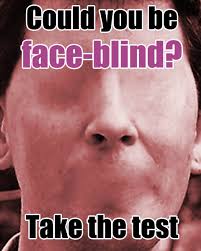 Called prosopagnosia.
Called prosopagnosia.
A cognitive disorder of face perception in which the ability to recognize familiar faces, including one’s own face, is impaired.
Other aspects of visual processing and intellectual functioning remain intact.
Originally referred to a condition following acute brain damage, but a congenital or developmental form of the disorder also exists.
Affect up to 2.5% of the United States population.
The specific brain area usually associated with prosopagnosia is the fusiform gyrus, or fusiform face area.
The fusiform face area activates specifically in response to faces. and allows most people to recognize faces in more detail than they do similarly complex inanimate objects.
The right hemisphere fusiform gyrus is more often involved in familiar face recognition than the left.
The right amygdala is associated with response to fearful stimuli as well as face recognition.
There are two types of facial blindness: acquired and congenital.
Acquired prosopagnosia results from occipito-temporal lobe damage and is most often found in adults.
Acquired prosopagnosia can be further subdivided into apperceptive and associative prosopagnosia.
In congenital disease, the patient never adequately develops the ability to recognize faces.
No therapy has demonstrated lasting improvement.
Sufferers learn to use recognition strategies, involving secondary clues such as clothing, gait, hair color, skin color, body shape, and voice.
As the face seems to function as an important identifying feature in memory, it can be difficult for people with this condition to keep track of information about people, and to socialize normally with others.
Facial blindness also associated with other disorders that are associated with nearby brain areas: left hemianopsia, associated with damage to the right occipital lobe), deficits in color perception, often topographical disorientation.
Apperceptive prosopagnosia describes cases of acquired prosopagnosia with some of the earliest processes in the face perception system.
The brain areas thought to play a critical role in apperceptive prosopagnosia are right occipital temporal regions.
People with this disorder cannot make any sense of faces.
Such patients are unable to make same-different judgments when they are presented with pictures of different faces.
Such patients are unable to recognize both familiar and unfamiliar faces.
Patients may be able to recognize people based on non-face clues such as their clothing, hairstyle, skin color, or voice.
Associative prosopagnosia refers to cases of acquired prosopagnosia with spared perceptual processes but impaired links between early face perception processes and the semantic information we hold about people in our memories.
Right anterior temporal regions may also play a critical role in associative prosopagnosia.
In associative prosopagnosia patients may be able to see whether photos of people’s faces are the same or different and derive the age and sex from a face, but may not be able to subsequently identify the person or provide any information about them.
Developmental prosopagnosia, also called congenital prosopagnosia, refers to a face-recognition deficit that is lifelong.
Developmental prosopagnosia manifests in early childhood, and is not attributed to acquired brain damage.
It is suspected to be a genetic condition, with one or more family members involved.
Often runs in families and is compatible with an autosomal dominant inheritance.
Some disorders have prosopagnosiac components including: nonverbal learning disorder, Alzheimer’s disease, and autism in general.
Can be caused by lesions in the inferior occipital areas, fusiform gyrus and the anterior temporal cortex.
Positron emission tomography (PET) and fMRI scans have shown that these areas are activated specifically in response to face stimuli.
The inferior occipital areas are mainly involved in the early stages of face perception and the anterior temporal structures integrate specific information about the face, voice, and name of a familiar person.
Acquired disease can develop as the result of several neurologically damaging causes.
Vascular causes include posterior cerebral artery infarcts and hemorrhages in the infero-medial part of the temporo-occipital area.
These can be either bilateral or unilateral.
Unilateral vascular changes are almost always in the right hemisphere.
Right hemisphere damage to the specific temporo-occipital areas is sufficient to induce prosopagnosia.
MRI scans of patients with prosopagnosia showed lesions isolated to the right hemisphere.
Less common etiologies include carbon monoxide poisoning, temporal lobectomy, encephalitis, neoplasm, right temporal lobe atrophy, trauma, Parkinson’s disease, and Alzheimer’s disease.
There are only a few neuropsychological assessments that can definitively diagnose prosopagnosia.
No widely accepted treatments.
Acquired prosopagnosia, generally has a poor outlook, but sometimes spontaneously resolves on its own.
Different people may show different types and levels of impairment.
A holistic processing of the face is what is damaged.
Individuals are able to recognize the specific spatial layout and characteristics of facial features, but they are unable to process them as one entire face.
Many with developmental prosopagnosia report they had no idea that they had a deficit in face processing, unaware that others could distinguish people solely on facial differences.
In children the diagnosis may be overlooked as they may just appear to be very shy or slightly odd due to their inability to recognize faces.
